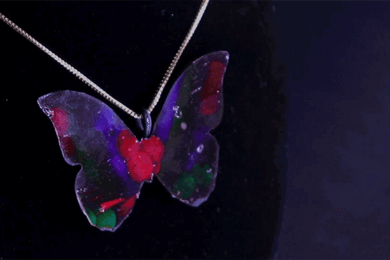People with type 1 diabetes must keep a careful eye on their blood glucose levels: Too much sugar can damage organs, while too little deprives the body of necessary fuel. Most patients must prick their fingers several times a day to draw blood for testing.
To minimize that pain and inconvenience, researchers at MIT’s Spectroscopy Laboratory are working on a noninvasive way to measure blood glucose levels using light.
First envisioned by Michael Feld, the late MIT professor of physics and former director of the Spectroscopy Laboratory, the technique uses Raman spectroscopy, a method that identifies chemical compounds based on the frequency of vibrations of the bonds holding the molecule together. The technique can reveal glucose levels by simply scanning a patient’s arm or finger with near-infrared light, eliminating the need to draw blood.
Spectroscopy Lab graduate students Ishan Barman and Chae-Ryon Kong are developing a small Raman spectroscopy machine, about the size of a laptop computer, that could be used in a doctor’s office or a patient’s home. Such a device could one day help some of the nearly 1 million people in the United States, and millions more around the world, who suffer from type 1 diabetes.
Researchers in the Spectroscopy Lab have been developing this technology for about 15 years. One of the major obstacles they have faced is that near-infrared light penetrates only about half a millimeter below the skin, so it measures the amount of glucose in the fluid that bathes skin cells (known as interstitial fluid), not the amount in the blood. To overcome this, the team came up with an algorithm that relates the two concentrations, allowing them to predict blood glucose levels from the glucose concentration in interstitial fluid.
However, this calibration becomes more difficult immediately after the patient eats or drinks something sugary, because blood glucose soars rapidly, while it takes five to 10 minutes to see a corresponding surge in the interstitial fluid glucose levels. Therefore, interstitial fluid measurements do not give an accurate picture of what’s happening in the bloodstream.
To address that lag time, Barman and Kong developed a new calibration method, called Dynamic Concentration Correction (DCC), which incorporates the rate at which glucose diffuses from the blood into the interstitial fluid. In a study of 10 healthy volunteers, the researchers used DCC-calibrated Raman spectroscopy to significantly boost the accuracy of blood glucose measurements — an average improvement of 15 percent, and up to 30 percent in some subjects.
The researchers described the new calibration method and results in the July 15 issue of the journal Analytical Chemistry. In addition to Feld, Barman and Kong, authors include Ramachandra Rao Dasari, associate director of the Spectroscopy Lab, and former postdoctoral associate Gajendra Pratap Singh.
Michael Morris, professor of chemistry at the University of Michigan, says the group appears to have solved a problem that has long stymied researchers. “Getting optical glucose measurements of any sort is something people have been trying to do since the 1980s,” says Morris, who was not involved in this study. “Usually people report that they can get good measurements one day, but not the next, or that it only works for a few people. They can’t develop a universal calibration system.”
Morris says the noninvasive nature of Raman spectroscopy could help boost quality of life for diabetes patients, but that to be practical, any device would need to become more affordable and very simple to use. The Spectroscopy Lab researchers believe that the smaller machine they are now developing should substantially drive down costs by miniaturizing and reducing the complexity of the instrument.
Barman and Kong plan to launch a clinical study to test the DCC algorithm in healthy volunteers this fall. Their work is funded by the National Institutes of Health and National Center for Research Resources.
In October, Barman will receive the Tomas A. Hirschfeld Award at the Federation of Analytical Chemistry and Spectroscopy Societies Conference, for his work on improving spectroscopy-based glucose measurements.
To minimize that pain and inconvenience, researchers at MIT’s Spectroscopy Laboratory are working on a noninvasive way to measure blood glucose levels using light.
First envisioned by Michael Feld, the late MIT professor of physics and former director of the Spectroscopy Laboratory, the technique uses Raman spectroscopy, a method that identifies chemical compounds based on the frequency of vibrations of the bonds holding the molecule together. The technique can reveal glucose levels by simply scanning a patient’s arm or finger with near-infrared light, eliminating the need to draw blood.
Spectroscopy Lab graduate students Ishan Barman and Chae-Ryon Kong are developing a small Raman spectroscopy machine, about the size of a laptop computer, that could be used in a doctor’s office or a patient’s home. Such a device could one day help some of the nearly 1 million people in the United States, and millions more around the world, who suffer from type 1 diabetes.
Researchers in the Spectroscopy Lab have been developing this technology for about 15 years. One of the major obstacles they have faced is that near-infrared light penetrates only about half a millimeter below the skin, so it measures the amount of glucose in the fluid that bathes skin cells (known as interstitial fluid), not the amount in the blood. To overcome this, the team came up with an algorithm that relates the two concentrations, allowing them to predict blood glucose levels from the glucose concentration in interstitial fluid.
However, this calibration becomes more difficult immediately after the patient eats or drinks something sugary, because blood glucose soars rapidly, while it takes five to 10 minutes to see a corresponding surge in the interstitial fluid glucose levels. Therefore, interstitial fluid measurements do not give an accurate picture of what’s happening in the bloodstream.
To address that lag time, Barman and Kong developed a new calibration method, called Dynamic Concentration Correction (DCC), which incorporates the rate at which glucose diffuses from the blood into the interstitial fluid. In a study of 10 healthy volunteers, the researchers used DCC-calibrated Raman spectroscopy to significantly boost the accuracy of blood glucose measurements — an average improvement of 15 percent, and up to 30 percent in some subjects.
The researchers described the new calibration method and results in the July 15 issue of the journal Analytical Chemistry. In addition to Feld, Barman and Kong, authors include Ramachandra Rao Dasari, associate director of the Spectroscopy Lab, and former postdoctoral associate Gajendra Pratap Singh.
Michael Morris, professor of chemistry at the University of Michigan, says the group appears to have solved a problem that has long stymied researchers. “Getting optical glucose measurements of any sort is something people have been trying to do since the 1980s,” says Morris, who was not involved in this study. “Usually people report that they can get good measurements one day, but not the next, or that it only works for a few people. They can’t develop a universal calibration system.”
Morris says the noninvasive nature of Raman spectroscopy could help boost quality of life for diabetes patients, but that to be practical, any device would need to become more affordable and very simple to use. The Spectroscopy Lab researchers believe that the smaller machine they are now developing should substantially drive down costs by miniaturizing and reducing the complexity of the instrument.
Barman and Kong plan to launch a clinical study to test the DCC algorithm in healthy volunteers this fall. Their work is funded by the National Institutes of Health and National Center for Research Resources.
In October, Barman will receive the Tomas A. Hirschfeld Award at the Federation of Analytical Chemistry and Spectroscopy Societies Conference, for his work on improving spectroscopy-based glucose measurements.








